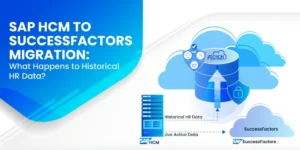It’s well known that managing ever-increasing amounts of data generated from various sources is not easy. It’s challenging to find a one-size-fits-all solution that is effective in handling rapid rates of data growth from multiple sources. This is where data archival comes into play. SAP HANA with its powerful capabilities for data management and analytics is an exception that has emerged as the go-to solution for many businesses, empowering them with better performance and end-user experience.
SAP data archival
One of the critical challenges large businesses face is the exponential growth of SAP data. Organizations typically struggle to strike a balance between operational and data storage costs—this is where SAP data archival comes into play.
SAP data archival is a process that helps in moving less frequently accessed data outside your SAP system while keeping it accessible for future reference. By archiving data in SAP, organizations can free up valuable storage space in their primary system resulting in optimized performance and reduced costs.
The use of the right tools and techniques plays a pivotal role in implementing an effective SAP archiving solution. They help in defining and executing archiving objects, specifying archiving criteria, and retrieving data when needed. These tools streamline the archiving process and ensure data consistency and integrity.
Key characteristics of SAP HANA
Migrating from legacy systems to SAP HANA is a complex endeavor that demands careful planning, precise execution, and a comprehensive understanding of the organization’s data landscape. One of the fundamental steps in this transformation is minimizing the data footprint, which involves strategically evaluating the data ecosystem. This entails identifying and categorizing the data based on its relevance, frequency of access, and compliance requirements. By doing so, organizations can ensure that only crucial and frequently used data is migrated to the high-performance storage system provided by SAP HANA.
The benefits of archiving SAP data are multifold:
Improved Performance
By migrating only essential data to SAP HANA’s hot storage, organizations can harness the power of its in-memory computing capabilities to achieve significantly faster data processing and analysis. This leads to improved overall system performance, enabling quicker execution of complex queries and real-time analytics.
Faster Query-Response Time
With the minimized data footprint, the queries executed on the SAP HANA platform become more streamlined. The reduced volume of data to be processed translates to quicker query-response times, enabling business users to make informed decisions promptly.
Reduced Cost of Storage
Storing data in high-performance systems like SAP HANA can be costlier compared to traditional storage solutions. By migrating only pertinent data and archiving everything else, organizations can minimize storage costs as they are no longer required to allocate resources to hold less critical or infrequently accessed data.
Reduced Cost of Maintenance
Legacy systems often demand substantial maintenance efforts such as routine backups, updates, and system optimizations. By transferring only the most relevant data to SAP HANA, organizations can potentially retire or consolidate legacy systems that were previously dedicated to storing all data types. This results in reduced maintenance complexity and costs associated with managing multiple systems.
Moreover, data that is retained for compliance and regulatory purposes can be systematically archived or moved to lower-tier storage solutions, such as near-line storage. This not only ensures adherence to legal requirements but also maintains data integrity and accessibility while freeing up the primary repository for more active and essential data.
The process of archiving and optimizing your critical data doesn’t need to be complicated. Working with experts can help you build tailor-made SAP data archival solutions that align with your requirements.
Roadmap to a successful data archival before migrating to SAP HANA
Data archival and migration in SAP HANA requires careful planning and adherence to best practices. Of course, a granular level of data retention and retrieval is key to an effective migration process. To achieve that, it is important to take a holistic approach to managing data and walk along the lines of these key steps to follow when archiving data in SAP:
Assess your data
Know your data landscape and identify which data is suitable for archiving. Typically, data that is infrequently accessed, has reached its retention period, or is no longer needed for day-to-day operations can be considered for archiving.
Define archiving objects
SAP provides pre-defined archiving objects for various modules and transactions. Evaluate these objects and determine the ones that are relevant to your business. You can also create custom archiving objects to meet specific requirements and plan the archival timeline accordingly.
Set archiving criteria
Specify the criteria for determining which data should be archived. This can include document types, date ranges, specific attributes, or any other relevant parameters. Fine-tuning these criteria is important to ensure that only the necessary data is archived.
Execute the archiving process
Once the archiving objects and criteria are defined, execute the archiving process using appropriate SAP archiving tools. This process moves the selected data from the primary system to a secondary storage system while maintaining its integrity and accessibility.
Validate and retrieve archived data
After the data archiving process is complete, it is crucial to validate the archived data to ensure its accuracy and completeness. SAP transactions allow you to retrieve data and allow authorized users to access and view archived data when required.
The rapid growth of data can pile on the systems and bring down efficiency. While archiving your data, an automated dashboard tool can help you visualize your data and understand its footprint. This helps in knowing what data is stored where and allows you to analyze it as needed. Once the data is archived, metadata tools keep you covered in managing the data retention period at a granular level.
SAP HANA is a game-changer in the world of data management for large businesses. With its robust archival capabilities and tools, SAP empowers organizations to efficiently archive and manage their data, ensuring enhanced efficiency, regulatory compliance, and improved decision-making.
By following best practices and utilizing SAP archiving solutions, large businesses can reap the rewards of a streamlined data management process, reduced storage costs, and improved operational excellence.
Need guidance with this process? At Platform 3 Solutions, we provide archiving, decommission, and migration as a completely managed service. If you haven’t explored the benefits of SAP data archiving yet, consult our experts to take the leap and transform your data management processes.
Platform 3 Solutions is a global leader in end-to-end legacy application migration and retirement solutions. Platform 3 empowers secure and seamless transitions of data and applications, eliminates technology debt, and delivers the ROI to invest in technology modernization.



